Smith and Wesson brought out a brace of 9mm handguns in 1980. The 2nd generation of autos was introduced with the Models 439 and 459. These were anticipated and appreciated, but the other 9mm they brought out was not expected at all–it was a revolver.
Details
The new Model 547 revolver was built on the K-Frame, and equipped with fixed sights on the heavy bull barrel. It sported a blued finish, and was offered with either a four-inch barrel and square butt, or as a three-inch round butt. The square butt version wore conventional Magna service grips and weighed 34 ounces. The round butt came with unusual, walnut target grips with a speedloader relief cut on the left panel, and weighed in at 32 ounces. The front and backstrap lacked serrations, but the 1/8” front sight did not.
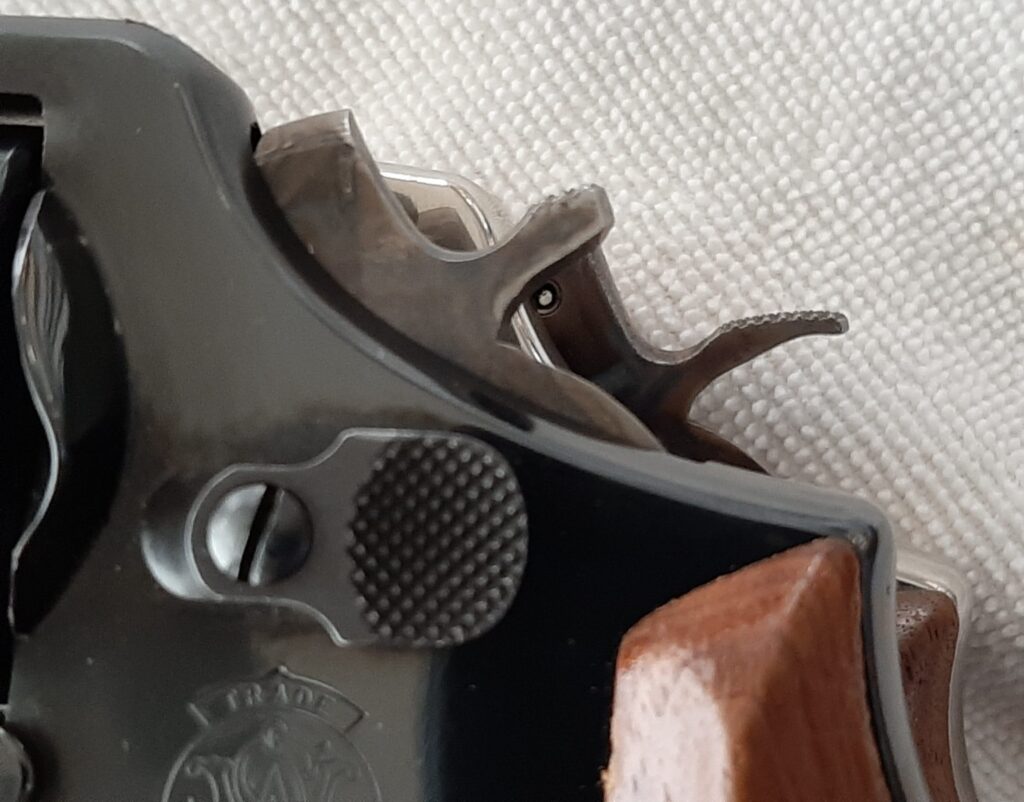
They came with nicely case-colored triggers and hammers. The well designed, smooth faced combat trigger measured .312” wide. The hammer was a service style, measuring .265” wide. It differed from a normal M&P hammer as it was “semi-bobbed,” and was visually shorter in length. Thumb cocking it revealed a flat front with no hammer nose; The firing pin was mounted in the frame. The barrel rode over a non-shrouded extractor rod and was scribed with “9MMCTG. PAT.4127955” on its right side. The cylinder was fluted and shared the length of a K frame .357 Magnum cylinder at 1.67”. At first glance, it looked like a Model 13 with a shortened hammer.
The French connection
Writers of the day suggested that the Model 547 was developed in response to an inquiry from the French government, in the late 1970’s, to provide a 9mm revolver for police use. One of their requirements was a revolver that could function with the rimless 9mm round without using moon clips. Roger Curran, who was the Director of Research and Development at S&W at that time, led the project.
At some point, the French reconsidered and took a different path. Curran had invested a lot of time and resources in the project and drove on. After three years, the 547 was introduced to the United States commercial market. It was no easy task getting it to work right without moon clips. Curran’s team came up with some incredibly innovative ways to make the 547 function like the French had originally requested.
Under the hood
The unique looking hammer, and what was going on underneath it, was critical to the successful function of the gun. Hardcore S&W folk will note the 547’s frame mounted firing pin showed up about 20 years before “normal” S&W revolvers got theirs. This engineering change didn’t occur until 1997/1998 for most other models. It was used in the 547 along with some other parts to deal with the complexities of operating with the 9mm cartridge.
Revolver cases use their rim to achieve proper headspace. On an auto cartridge, the case headspaces on the forward edge of the case in the charge hole chamber. The 9mm was loaded all over the world to vastly different pressures and case length variations. Add the slight taper inherent to the case and it makes cases very prone to backing out of charge holes upon firing. This leads to pierced primers and case heads smashing into the recoil shield. It can impede cylinder movement and even lock the cylinder up. Smith & Wesson engineers were used to dealing with this problem, because of the Model 53 revolver and its bottlenecked .22 Jet round. The headaches with the Jet led to solutions that worked well in the 547.
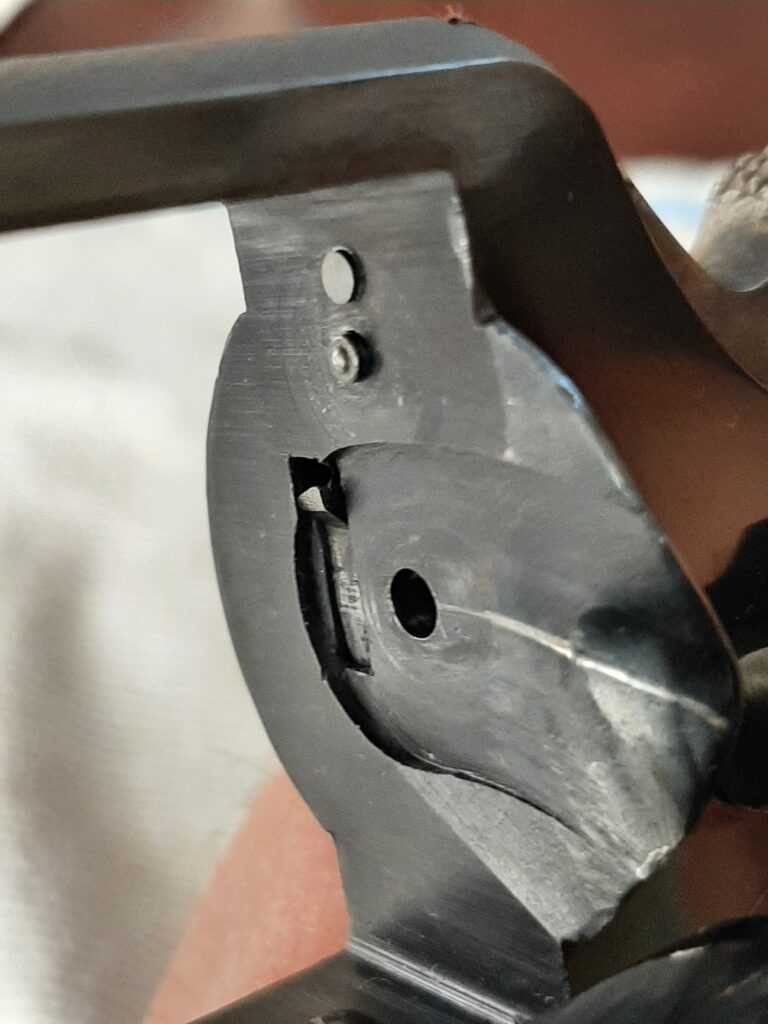
The engineers designed and installed a patented “limit pin” directly above the firing pin in the frame, both of which were spring loaded. When the hammer falls on a 547, it drives both the firing pin and the limit pin through the bolster (“breech,” in S&W-speak) face. The firing pin strikes the primer, and the limit pin bears on the cartridge’s head, limiting case set back. The force from the case setting back actually transfers through the limit pin, and forces the hammer rearward. This allows the firing pin to move away from the primer, and prevents primer piercing. The rearward movement of the hammer can be significant, depending on the pressure of the ammunition, which is why the hammer spur was bobbed—shortening it decreases the probability of the spur pinching the web of the shooting hand, in recoil.

The 547’s firing pin is also unusual. It travels through the bolster face at full diameter, but steps down with a sharp shoulder to form a smaller diameter tip. The hammer delivers a lot of force to the firing pin because of the more powerful mainspring in the 547. The strain screw is also longer to provide more tension on the spring. These modifications were necessary to guarantee ignition with the hard primers found in some military surplus ammunition. The limit pin controls the depth of the hard strike delivered by the firing pin. Smith & Wesson engineers estimated that the gun would pierce up to 80% of primers on some types of ammo without the limit pin.
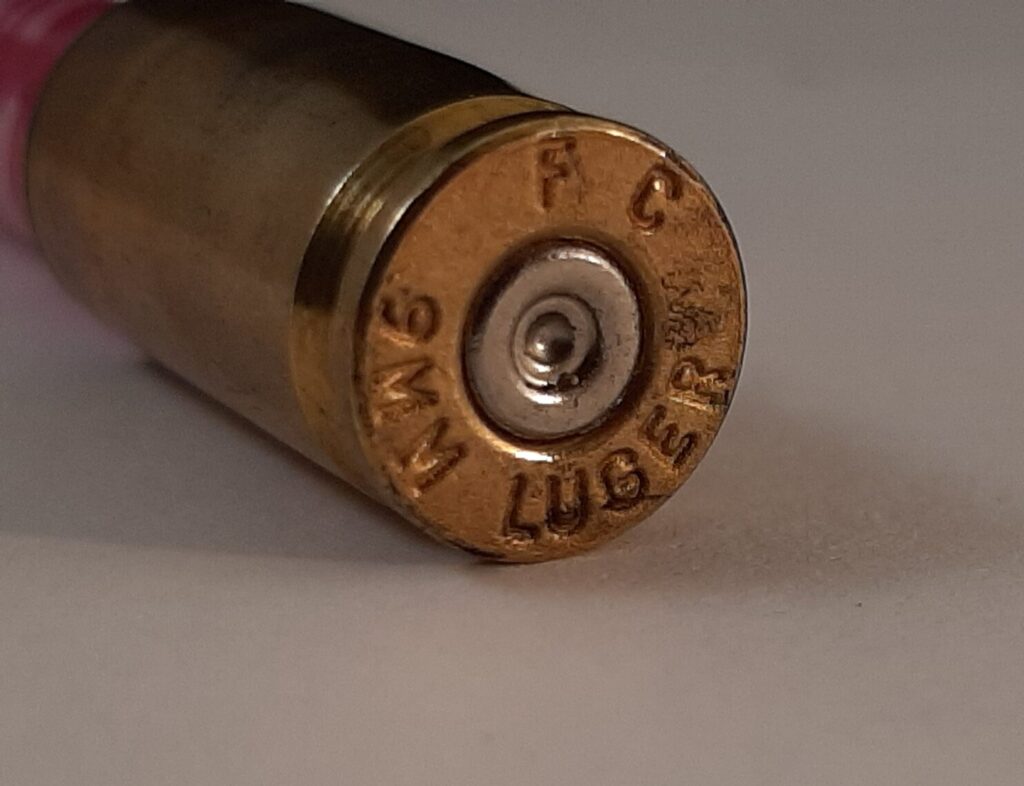
The trigger pull is smooth, like all K-Frames of that era, but it’s heavier than normal, due to the beefed-up mainspring and longer strain screw—fourteen pounds on average for the double action, and three to five pounds for the single action pull. You can feel the extra pounds when you thumb cock one–it’s noticeably harder than a Model 10.
Extracting every bit of performance
The other perplexing problem with revolvers that fire auto pistol cartridges is extracting the rimless rounds. Moon clips give a conventional extractor something to grab onto (in addition to providing correct headspace), but the French buyers didn’t want to use them. Out of the box thinking was required to solve this problem.
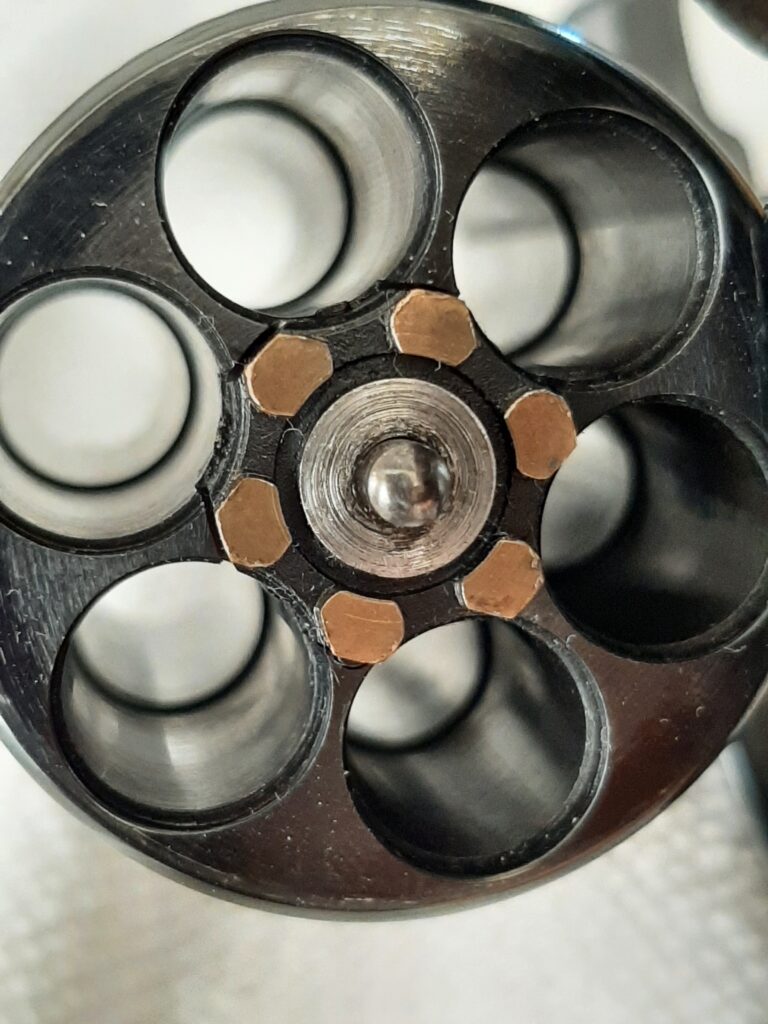
Curran and his team came up with a unique extractor, as a solution. The head and stem of the extractor were investment cast from beryllium copper. The copper was chosen for its low coefficient of friction and was heat treated to the same strength as steel. It also demonstrated excellent resistance to wear in testing. Each charge hole had a small spring steel leaf that fit in a groove when the extractor was at rest. With the extractor seated fully in the cylinder, cartridges could be dropped into charge holes as normal, because the extractor leaves were retracted. When the extractor rod was pressed, the end of each leaf expanded into the extractor groove of the case, allowing the extractor to push the case out of its chamber. Engineers were satisfied with the strength of the system and claimed the portion of the leaf that engaged the brass case head would tear completely through the brass without breaking.
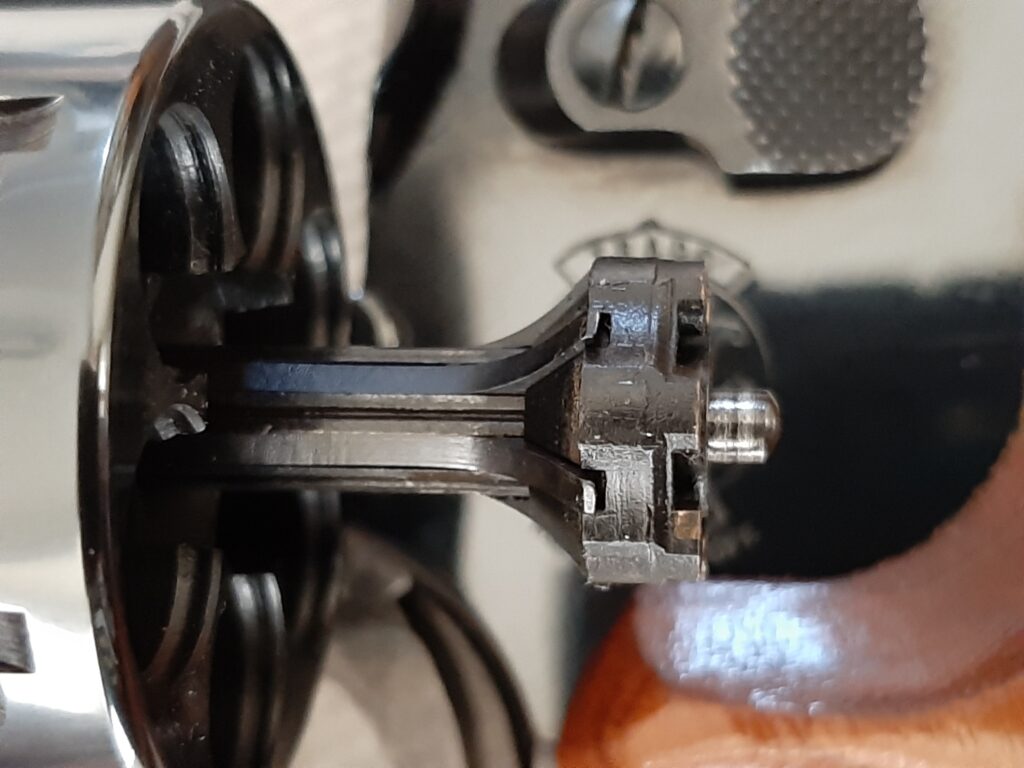
A welcome benefit of this type of extractor system was the elimination of dreaded failure-to-extract stoppages, where the rim of a revolver case becomes lodged underneath the extractor star. There was no extractor star! If a case failed to extract, a shooter would simply allow the extractor to return to rest, and try again. The steel leaf would compress past the case and give you another chance.
Ballistic edge
Industry testing demonstrated that the 9mm was ballistically superior to .38 Special loads of similar bullet weight. On paper, 124 grain 9mm’s would best 125 grain +P .38’s by over 100 fps from equivalent barrel lengths. Another advantage–that was counter intuitive, and ran against traditional thought–was that the revolver actually produced more velocity than a semi auto of equal barrel length, with the same ammunition.
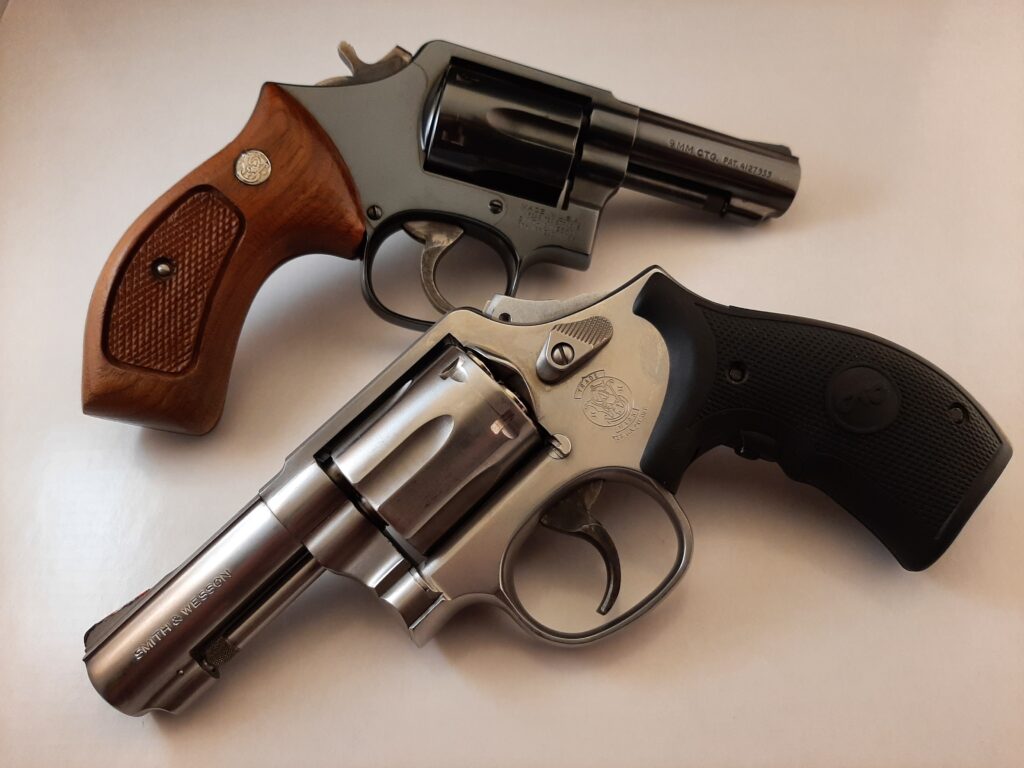
It was always assumed that the barrel-cylinder gap of the revolver would rob velocity and make it suffer in comparison to the solid barrel of a semi auto. The .357 Magnum-length cylinder gave almost 9/10 of an inch of “free bore” at the front of the cylinder, from the point that the chamber ends. After leaving the case, the bullet had room to accelerate prior to reaching the barrel-cylinder gap, the forcing cone, and the resistance of the rifling. The same round fired from a semi auto chamber will encounter rifling, and therefore resistance, before the bullet has even fully left the case in most chambers.
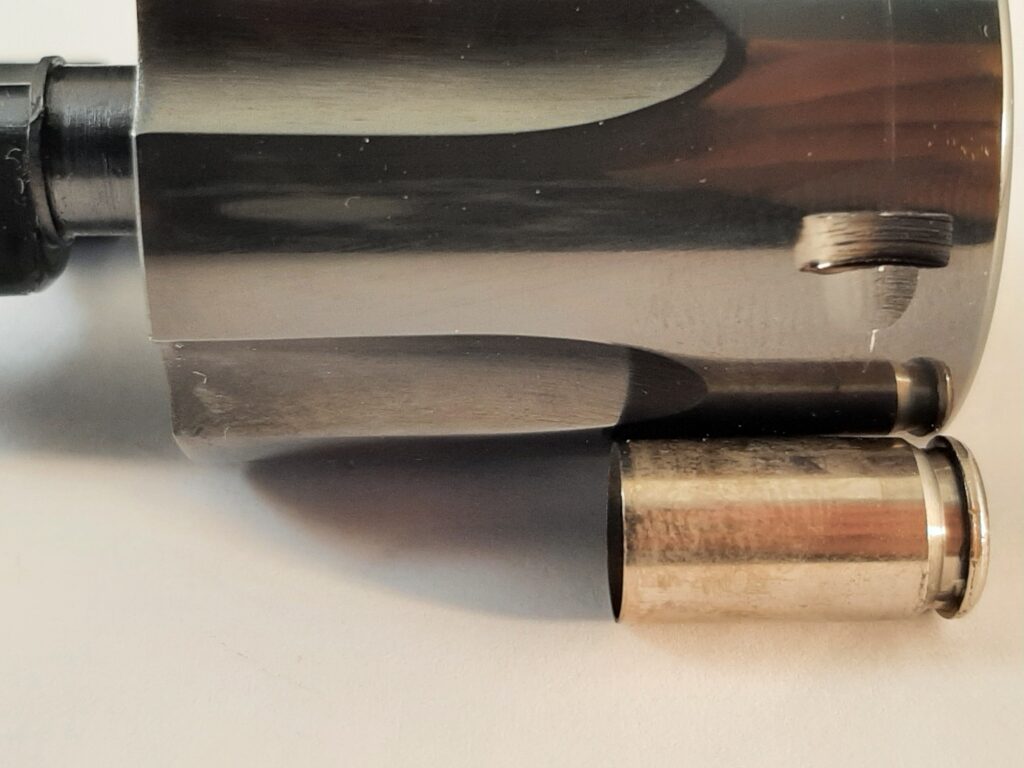
I chronographed some ammo through a 3” Model 547 a while back, along with a 4 ¼” barrel S&W M&P Auto, and velocities were very close. The 547 recorded higher velocity than the M&P with one round out of the four tested. I decided to repeat this test using semiautos with barrels closer in length to the 547– a Shield with a 3.1” barrel, and a Model 6946 with a 3.5” barrel. Rounds were fired across a Pro-Chrony Chronograph, 12 feet from the muzzle. The temperature was 83 degrees Fahrenheit at an altitude of 5,600 feet above sea level. Five-round strings were fired with each of these common bullet weight factory loads, with the following averages:

The 547 turned in the highest velocity of the three guns, with four of the five rounds tested. A S&W Model 65 3” was used to test .38 Special and 357 Magnum loads for comparison to the 9mm ammunition:

The 9mm 147 grain topped the .38 Special 147 grain, even though the .38 was a +P+ loading, and the 9mm was loaded to standard pressure. The 9mm SAAMI pressure ceiling of 35,000 psi certainly helps it in this contest, as it can operate at double the pressure of standard .38 ammo.
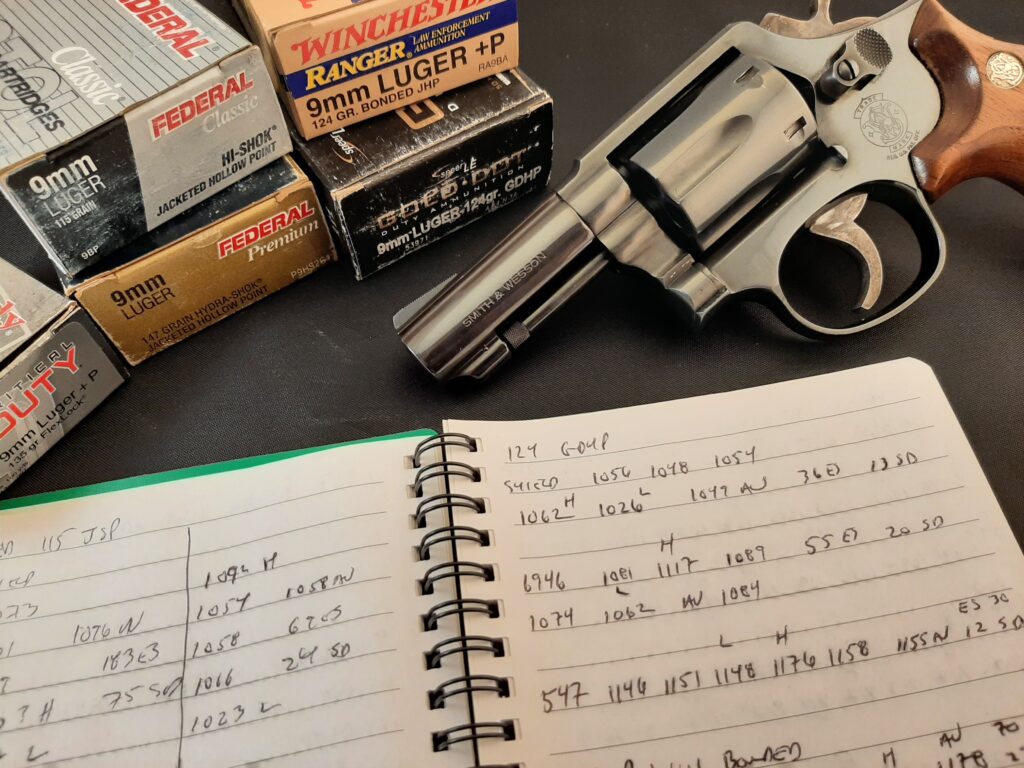
The 9mm completely outclassed the .38 Special with 124/125 grain bullets. The Winchester Ranger +P 124 grain bonded JHP bested the .38 +P Remington Golden Saber by a whopping 260 fps. When fired through the 547, this round lands solidly in mid-range .357 Magnum territory, as evidenced by the .357 Golden Saber velocity. The 125 grain .357 Magnum DPX load is about the high end for a reasonable carry load (for me), in a 3” K frame .357, but only outruns the 9mm Winchester Ranger 124 +P by about 100 fps. The old Remington 125 grain JHP is much faster, beating the 9mm by a wide margin (247 fps), and is one of the rounds that made the fearsome “one shot stop” reputation of the .357 Magnum. However, its viability as a carry load is limited in a gun this size. With respect to recoil and blast, it is a nasty spewing beast, and the 9mm loads are much more friendly.
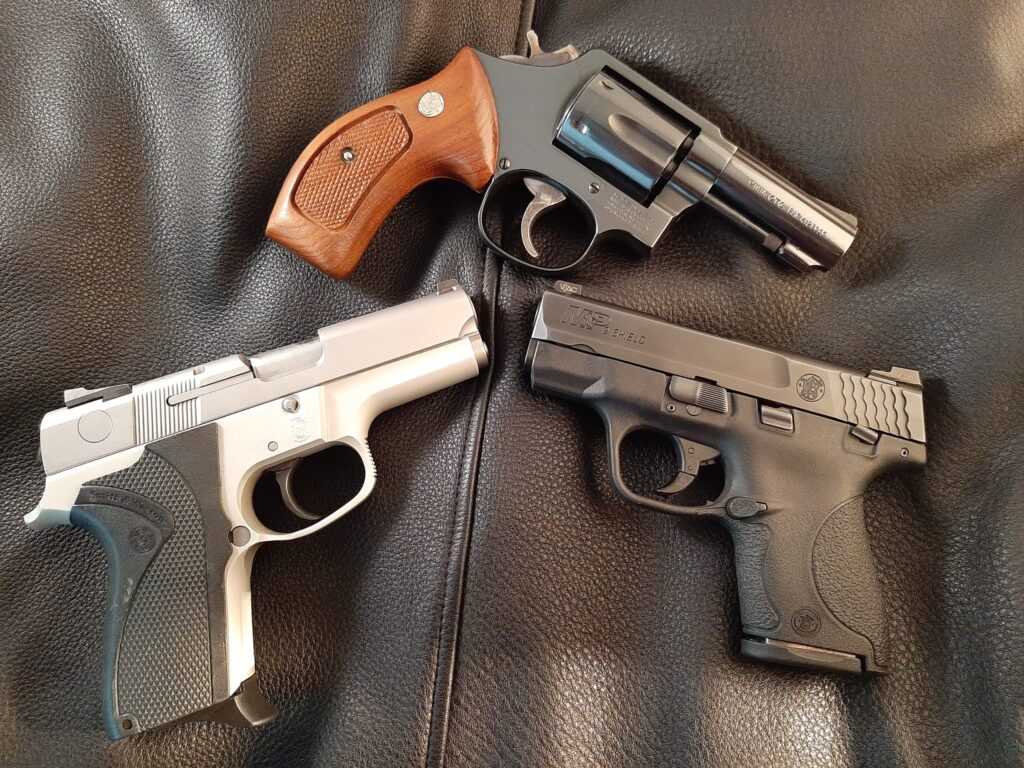
The 9mm 124 grain loadings struck an excellent balance between power and controllability, and both hit to the sights (vertically) in the 547. Like the mid-range (aka, low recoil) .357 loads, they are a near perfect loading for a 3” K frame carry gun.
Shots fired
I have shot the 547 enough to get a good feel for it. Ignition has been 100% with all ammunition fired. It has been reliable with 115 grain factory FMJ from various makers, NATO-spec 124 FMJ, commercial hollowpoints from the big manufacturers and smaller shops like Doubletap and Corbon, and cast bullet handloads that I have loaded for it. That reliability comes at a price with the 547, as the heavy trigger is harder to manage than comparable S&W K frames. I find that if I relax my grip even a little, and do not completely focus on my trigger press, shots will drift left.
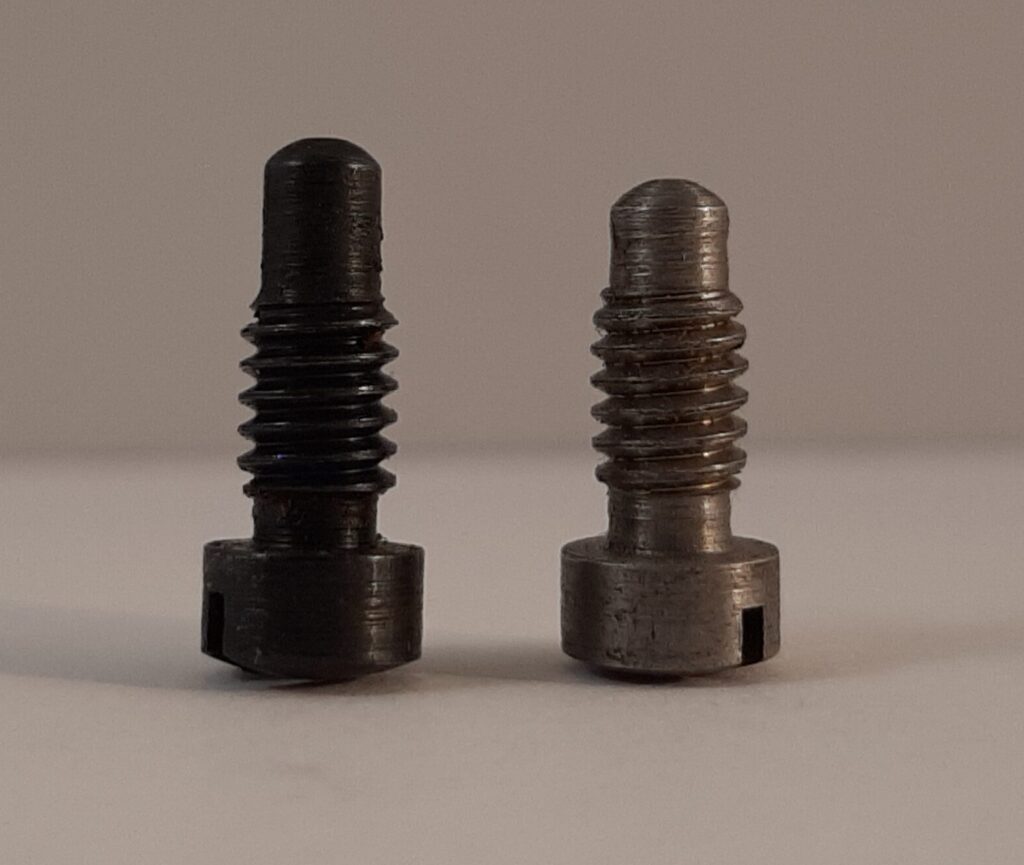
Comparing the strain screw from a standard K frame round butt to the 547’s reveals it is indeed noticeably shorter. Out of curiosity, I installed the standard K screw into the 547 and the trigger pull became . . . instantly delicious. I have not had a chance to shoot it yet, so altered, but I’m hoping it has enough “oomph” to bust commercial primers reliably. If the longer screw was strictly used to ignite Egyptian surplus submachinegun ammo, and the normal one will do the job with regular ammo, it will greatly improve the “shootability” of this gun!
Extraction of empties was also flawless with the 547. I treated it like any other revolver, primarily using the “universal” method– striking the extractor rod with my right palm. I occasionally used my left thumb to press the rod a la the FBI method. I never had to strike it twice.
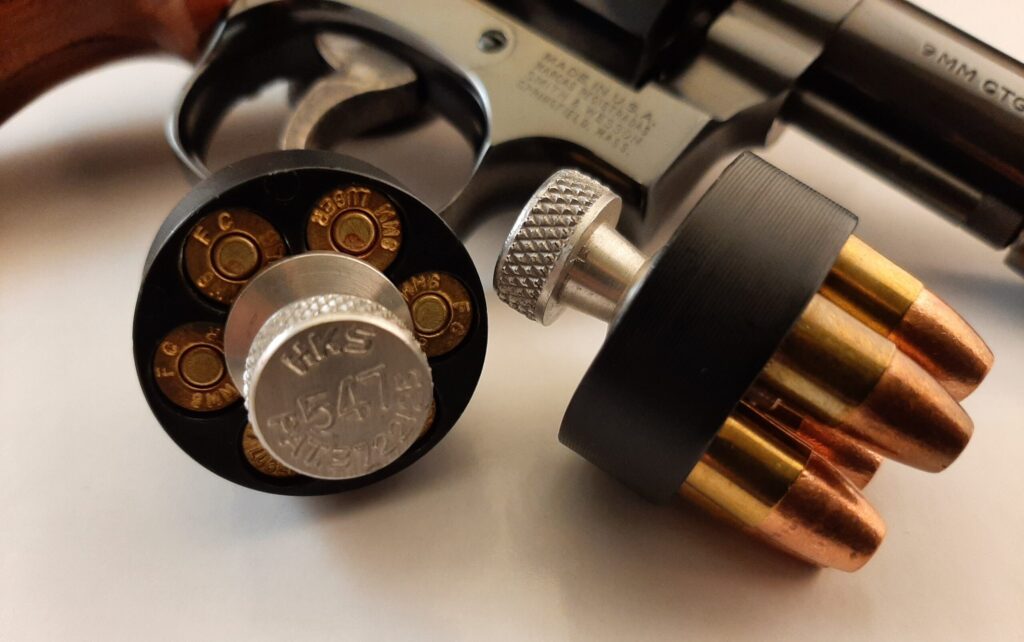
Reloading the gun was a little weird. HKS actually made a speedloader for the 547 (I would wager that they are the most uncommon HKS loader out there). The stubby 9mm rounds handle differently than long, skinny rounds like .357 Magnums. The first several times I tried to load with the HKS, I would bumble it, and lose at least one round. I found that using the center pin of the loader to push down on the extractor before twisting the knob gave better results. It seemed to set the extractor and allow the rimless rounds to fully seat in the chambers. If I tried to hurry the process, the loader would pinch a round and carry it with the loader as it was discarded.
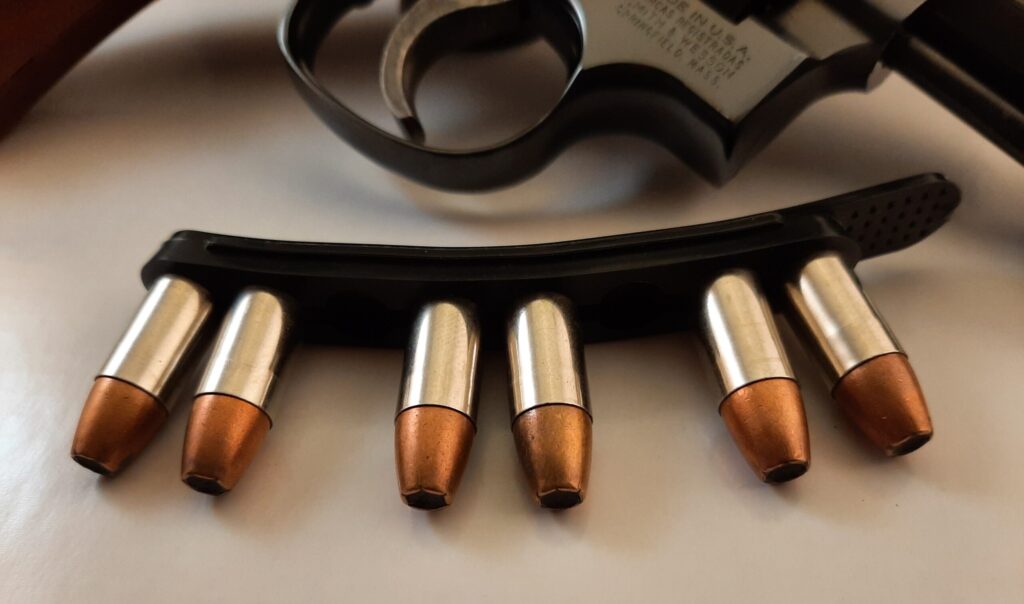
The key to loading the 547 was using deliberate movements. Rounds would occasionally not fully seat even when I did everything right. These would have to be pushed in with a fingertip before the cylinder could close. The 547 would hugely benefit from a spring-assisted loader like an SL Variant or a JetLoader. Tuff Products’ .32 caliber Quick Strips also fit 9mm rounds, and work really well with the 547. You can maintain pressure on the cartridge heads as you peel the strip off, and keep them in the charge holes. They were more reliable than the speedloader at getting six new ones in every time. The strips would be mandatory kit if you chose to carry this gun.
Missing in action
The 547 had a short production run from 1980-1985. Reportedly, only 10,270 guns were made, with 6,486 of them being 3” variants. The gun had one engineering change in 1982; The pinned barrel was deleted, and the three letter/four number serial number format was adopted at AAF—-. Internet rumors claim the 547 was S&W’s most expensive revolver to produce.
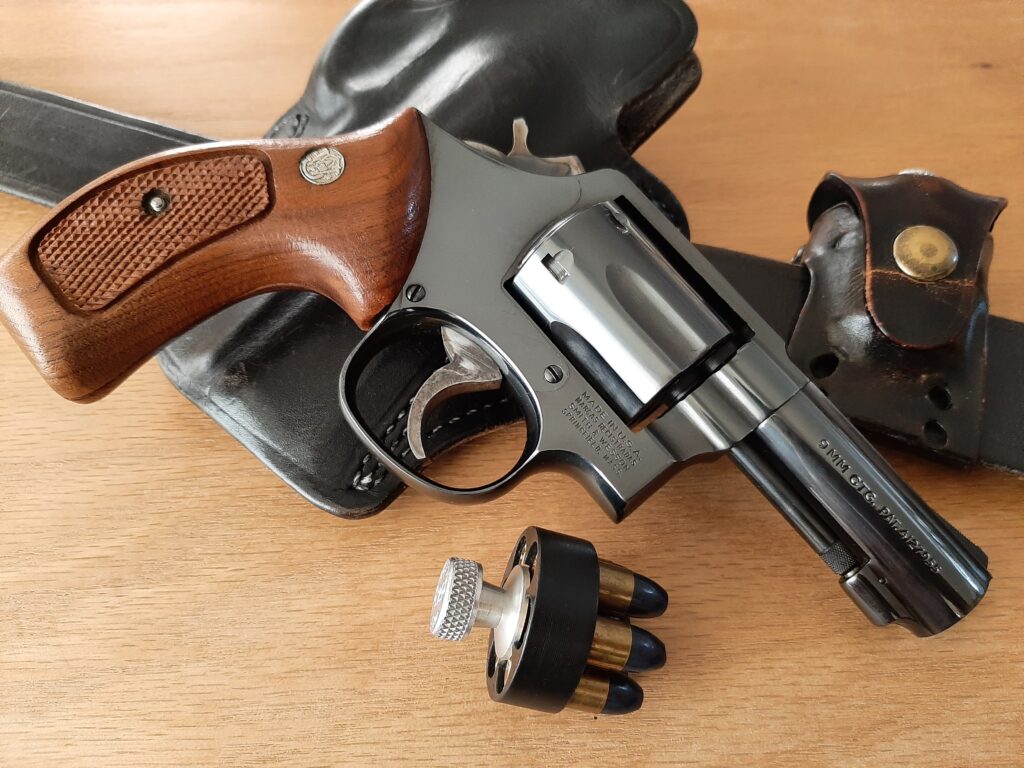
Maybe some of you readers have a better idea as to why it went away so soon? If so, please share, because decades later, this revolver still seems cutting edge!

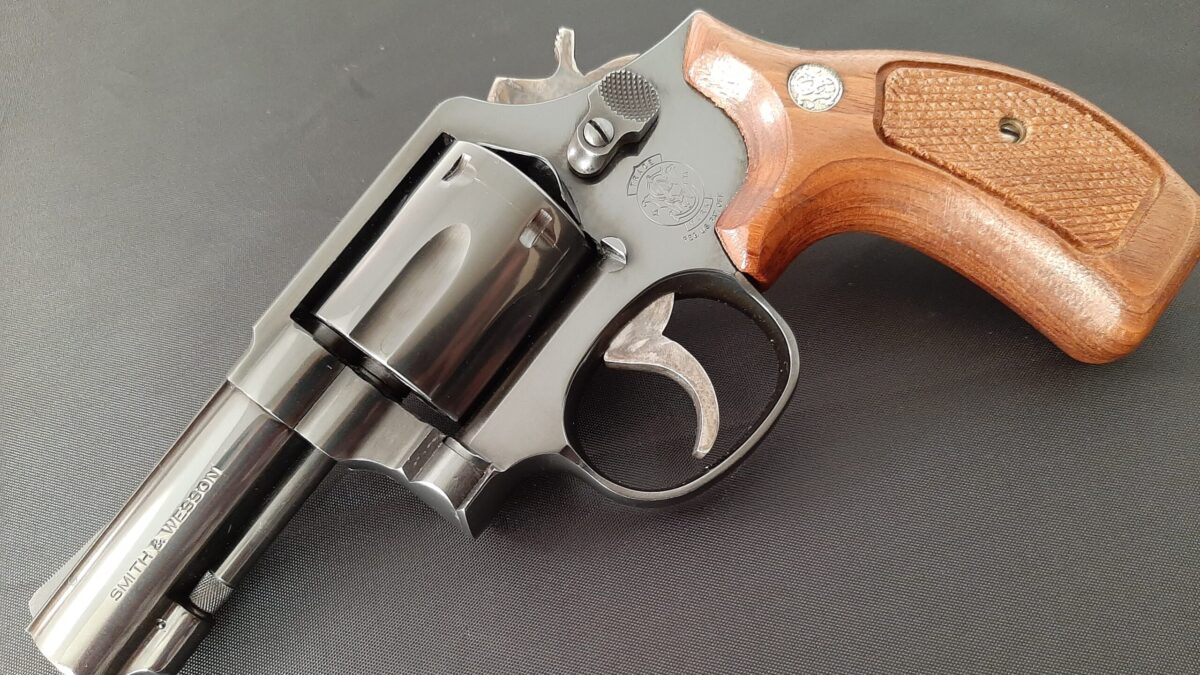
Kevin, thank you for the excellent review of this fascinating revolver! I really appreciated the detailed images of the extractor, as I’ve always been interested in this unique feature of the design.
I remember spending many hours studying the S&W catalogs as a young man, dreaming and scheming about all the guns I’d someday procure. I admit that the 547 absolutely puzzled me when it made its appearance—why would anyone pick a 9mm revolver when they could buy a 459, instead?
It made no sense to my young brain, but decades later, the attraction is inescapable! The 9mm revolvers hold a special fascination for me, and particularly the 547. I’d be overjoyed to find one of these for sale in my A.O.
I find it interesting that Charter Arms has come the closest to replicating the design. I don’t normally associate that brand with technical advances, but they’re the only ones I can think of, that have used an extraction system like this. Steve wrote about it here, previously, and it seemed to work great on his sample. Now, if we could only combine the design with the old standards of fit and finish, walnut and blue steel!
Immediately, I’m transported back to that kid with his worn catalog and dreams!
Thank you, Mike! It is a fascinating revolver with unparalleled design features. If memory serves, Ruger put out a 9mm Speed Six around the same time that (at least initially) was billed as functional without moon clips. I’m sure there are readers that have knowledge on the Ruger that far exceed my memory!
Agreed on Charter Arms, hopefully they will stick with and continue to upgrade their advances on rimless cartridge revolver designs. It has always seemed like a worthy concept.
Kevin, thank you for that excellent presentation on the 547. I remember when that revolver came out and thought it was, well, quite an odd combination. Since the .357 was the go-to round at the time, I (sadly) passed on getting one.
I think folks tend to forget that Smith & Wesson was a trail blazer with designs that others danced around. There are auto pistols in police holsters today not because of Glock, or SIG, or Beretta (and whomever else), but because of Smith & Wesson. Their tenacity to work all of the bugs out of their first and second generation autoloaders, especially the 59 series, resulted in the best of the metal frame auto loading service pistols.
The 547 represents that engineering persistence to take an obvious problem, and many less than obvious problems, and come up with a not-so-obvious solution and make it work ! The 547 may not have been a market success, but thanks to the 547, we now have multiple S&W and Ruger revolvers chambered for the 9m/m Parabellum. Had S&W not gone down that path, who knows where we’d be now.
Great writeup !!
Thank you, S. Bond! You bring up some really good points on S&W. I look back now and appreciate how good their autos were. By the 3rd generation, S&W had definitely gotten the bugs out and they were extremely reliable. I trusted my life to a 5906 and a 4506 after shelving my revolver; they never let me down. A lot of fine work has come from Springfield through the years, good of you to point that out. They helped a lot of us go home a lot of nights. Thanks, S&W.
Kevin, my wife still carries a 30 year old S&W M3913 now on its 3d set of tritium night sights. Last tally, it’s had just around 5,000 rounds through it. It’s still tight as can be, has yet to malfunction (not including dud ammo). She’s been offered even up trades for the little Glocks and SIGs, and it’s no deal.
When it came time to retire the revolver for duty (a moment of silence) . . . we ended up with the SIG P226. The SIG is still a great pistol, but it was definitely an understudy to the S&W autos of the day.
Shifting gears to the Ruger Speed-Six 9m/m – if memory fails me as usual, the Speed-6 initially had a VERY short run using wire ring extractors within the extractor star. Those proved to be problematic (to be kind), and they soon dropped that and went to standard moon clips which eliminated any guess work. The guns with the wire ring extractors apparently bring a pretty penny.
Leave it to the French to want an airplane with piston engines that doesn’t have propeller blades.
If it’s French, it’s weird and temperamental.
If it’s British, it’s weird, temperamental, and ugly.
; ^ )
“Leave it to the French to want an airplane with piston engines that doesn’t have propeller blades.”
Actually true! The Motorjet was French concept and developed by the Italians! The Caproni Campini N.1.
Hard to beat that 3913 your wife carries, S. Bond, even today. Hindsight as it is, I’m always hoping to stumble onto one of them.
Your memory rings true on the Speed Six, I think.
You and Mike made me chuckle with your “international observations”!
Mr. Bond:
I think you kind of nailed it regarding the reason for the 547’s demise: With so many .357 revolvers around in the same frame size, the 9mm was kinda just too weird. Why buy a K-frame in a different caliber when the 19, 66, 13, and 65 were ubiquitous (although the 3-inch 65 was a few years in the future yet. I’m not sure about the 3-inch 13.) And, of course, you also had the Ruger Security/Speed-Six line and the various Colts.
Another thing to remember is, during the 547’s lifetime, the 9mm didn’t have the reputation it has now; quite the opposite. The 9mm had a reputation as being a poor stopper, with JHPs not expanding enough and FMJs penetrating too much. In the early 80s a lot of PDs flatly forbade 9mm pistols for that reason. It wasn’t really till the 115-grain Silvertip and similar 9mm rounds became widely available that the 9mm really gained traction (and the Silvertip’s failure in the Miami FBI shootout, though it happened after the 547 had already been discontinued, set it back again). The 9mm rounds used in this testing mostly didn’t exist in the early 80s, so while their performance against the .38 and .357 is relevant today, it wasn’t during the 547’s lifetime.
During the early 80s I was an iconoclastic 9mm fan and I was interested in the 547. I hung out at an upscale gun store that always was the first to have anything new, and I never saw a 547 there or anywhere else. At the time, it couldn’t compete with its .357 counterparts.
You bring up good points, Old 1811. The 9mm in a K frame revolver back then was an unusual choice. Your observations about modern 9mm ammo are also astute. I tested it with some of the best modern ammo- a far cry from the ammo you could feed it in 1980. It makes the 547 as a carry choice today look far better than it would have back then.
I laughed at them when they came out. Now I want one. I’ve looked for years at local shows and never found a 547. I e seen them online for stupid money. My EDC gun is a Ruger LCR 9mm. With modern ammo it is an extremely effective combination. The full size S&W would be even better
I feel your pain, Brett. If we could go back with a pocketful of cash knowing what we know now!
I have to wonder if 547 experiences the slug jumping crimp as much as the LCR in 9mm?
Timothy, that looks like a .357-length cylinder . . . I’m guessing the bullet would have to travel much further to bind the 557 cylinder than it would on the LCR? Probably a non-issue in the bigger gun?
Additionally the K-Frame weighs a lot more than the LCR and won’t have the same “snap” during recoil. I doubt it’s a problem even with cheap ball. BTW I’ve never had the issue in my LCR with Speer Gold Dot ammo.
An excellent point, Brett. I think that’s Kevin’s assumption, too.
I had Federal HST creep forward a little during my LCR test, but not enough to tie things up. The two failures I had were with commercially-reloaded ball. I didn’t try any Gold Dot.
Hey Timothy,
I have not experienced bullets jumping crimp to any degree in the 547. Although I did not torture test ammo by subjecting a single loaded round in the cylinder to more than the normal amount of firings, it was never an issue in normal firing. I’m guessing the mass of the all steel 32 Ounce gun is sufficient to prevent the severe whip that lighter guns like the LCR produce.
Thank you, Kevin, for the story of a fascinating revolver. Wish I could afford one! I am about to take the plunge into 9 mm shooting with a Star pistol that belonged to my late brother. Now I will want a wheel gun to shoot the caliber as well.
S&W’s ingenious solution for ejecting brass using really impresses me. I like what Charter Arms has done with rimless ammo, but it seems “fiddly” and I worry about long-term reliability.
Moon clips do not bother me in the least. I bought a stack of Ranch Products clips and with the loading tool, they work great. Reloads in my Colt M 1917 are now a delight.
You’re welcome, Sir- glad you liked it! Revolvers shooting moon clipped ammo are certainly not a bad option, they offer advantages that many prefer. Enjoy that Star 9mm!
I remembered a 9mm revolver in HB Smiths Small Arms if the World. Here it is.
Search for the link using the keywords, “Israel’s Attempt At a 9mm Revolver–Silah Report,” and you’ll find it.
That’s fascinating, Brett. Thanks for sharing it!
I apologize for replacing the hyperlink you provided with the search words, but it’s a security measure for the site. Thanks for understanding.
That was really cool, Brett! I have heard rumors of that gun existing for a long time, but that’s the first time I have ever actually read the print and seen pictures. Thank you.
Kevin;
Glad you liked the 4506. When I went to CST, I spent seven and a half years in Colorado, and one of my jobs put me in contact w/Clint Wycoff, who was not only a very fine gentleman, but also the Western Regioal Director for S&W. At that time (winter-spring ’84) Para Ordnance was working on their training submachine gun that used 9MM cases loaded w/paintballs for livefire training for police departments, which had gotten an ATF waiver as a non-firearm, (probably because of not accepting standard ammo). I called Clint and asked him to speak with R&D at Springfield to “get them on the stick” w/the concept of double action/double stack using the 5906 platform, but he told me they weren’t interested. I left him with the thought that, “Well, you watch, somebody will run with this idea sooner or later” and within about 10-12 months Para Ordnance came out with their first model; So, I called Clint back and asked him what he thought and got a positive response.
Your reply to S. Bond brought that thought to the fore and I thought you might be interested in that missed opportunity by S&W, my favorite revolver. I enjoyed your article as I don’t remember anyone ever doing a similar comparison in the past, it’s well written and reminiscent of the informative type articles we were formerly used to. Thank you.
MEP, thanks for the great story about another missed opportunity, and the kind words about Kevin’s excellent work. We agree he does a great job, and appreciate him sharing his talents with us, here at RevolverGuy.
Hey MEP, Mr. Wycoff was just a little before my time, but I had the privilege of working with two fine gentlemen that served the same area a little later. Brent Perucker and Mark Dix were S&W LE District Managers that I got to know well. Both former cops, both the real deal. The kind of guys (like Wycoff, no doubt) that S&W was very wise to have rep their products to cops. Your suggestion that S&W passed on was certainly a missed opportunity. I wonder if they sit around and kick themselves for those passes like we do when we get rid of a gun that we shouldn’t? I kinda hope so!
Thank you very much for your complements on my article!
Great article on a forgotten piece of cool revolver technology. To me, part of the theoretical attraction of 9mm in a revolver, besides the wide availability of ammo, would be the ability to use a shorter cylinder, much like the original I-frame Smith & Wessons or the old Police Positives in .38 New Police, as opposed to the .38 Special/.32-20 models with the longer frame and cylinder. I know the difference is not a huge one, and the change would introduce more complexity for manufacturing, but it would produce a shorter, lighter, handier revolver. Here’s hoping someone does a “proper” 9mm wheelgun one of these days (with or without moon clips).
Steve H.
Thank you, Steve! I think there is a lot of merit to your suggestion about minimizing the dimensions of a 9mm revolver to old I frame specs. The Korth Sky Marshal 9mm popped into my head; but I’m not sure if NightHawk even still catalogs them. Alloy frame, short cylinder, good sights- what a concept, huh? Unfortunately, MSRP on that one was steeper than most of us could handle. I think the concealed carry market would support guns in the class you described and I sure wish S&W would step up. Build that 5 shot 9mm I frame in a steel and scandium framed version? Heck yeah! Bring out a similar .32 H&R Mag 6 shot while you’re at it, and a modern K frame Airweight .38? Please, S&W?
Sir I’m especially on board with a .32 variant! Sadly, I think only Charter Arms makes a .32 H&R Magnum right now. Well, and a company in India.
I’m pretty sure you and I wouldn’t be the only ones that would buy one if they would build them, Riley. Maybe we should start a petition?
Kevin,
I recently saw a Safariland Comp speedloader in its original package for a Model 547 come up on ebay. I can’t remember if it was the Comp I or Comp II style. I do remember it sold for $150.00!! I new about the HKS 547 but never knew that Safariland produced a speedloader for the 547. Definitely a rare accessory for the 547! Thanks for the great article.
Best regards,
Morgan Drew
Wow! I didn’t realize Safariland ever made a speedloader for the 547. That would be pretty close to a holy grail speedloader find. Thanks for the info on that, Morgan, and thanks for reading my article. I’m going to go surf ebay for one of those elusive high dollar Safarilands!
Looks like an interesting revolver for sure, although I suspect it was probably a pain to manufacture compared to traditional DA revolvers. Which is, I suspect, one of the reasons it was discontinued. Most people who were buying revolvers back then were likely buying them to shoot revolver cartridges and do revolver things. If they wanted a 9mm handgun, then they’d look at a pistol; a view that appears to have carried over to this day, considering the incredible niche 9mm revolvers (not the ones with interchangeable cylinders, but something like the Ruger LCR 9mm) occupy today outside of competition use.
This revolver absolutely had the right idea in regards to the ejector, as I’ve often heard other shooter complain about the fragility and sometimes finicky-ness of moon clips. Sadly, the market, and thus profit margin, for a revolver with a properly designed ejector for 9mm wasn’t, and apparently still isn’t, there.
Hey Axel, I think you are probably right on the money with everything you said. I doubt we will ever see a revolver like this from S&W again. It’s unfortunate though, because with modern 9mm ammo the 547 is a wickedly efficient 3″ K frame.
I think that 9mm Luger is a better option for short-barreled revolvers than a .38 Special or .357 Magnum. It´s easier to operate with short extractor rods, the extra ammo is less bulky, more powerful than a .38 Special +P and far easier to control than a .357 Magnum.
I´m thinking on change my worn Taurus 85S by a 905. Another advantage is to use the same standard caliber of our pistols. Sooner or later, the Department will take back my Taurus 66…
Hello, Erick! Based on my experience with the 547, I completely agree with everything you said. The short extractor rod issue would definitely be an advantage for the 9mm in 2″ J frame size guns like that Taurus 905. I believe that one is all steel and the weight would help with the additional recoil of the 9mm over most .38 loadings. I think I’d make that swap too if I were in your shoes. I hope you can hold on to that 66 though! Take care.
The 547 appeared at a time when the 9mm round was nowhere near as popular as it is these days. It really was geared towards the French LE contracts and was shopped to other foreign contracts. Only when these fell through did S&W offer them for US commercial sales.
Add to this the fact that S&W has so many resources devoted to the (then) new L-frames which were taking the commercial & Law Enforcement worlds by storm. Understandably, S&W gave a full effort to the L-frames.
Combined with the above mentioned and wisely reading the tea leaves regarding the future of Law Enforcement sidearms, S&W had entered into one of it’s most intensive R&D projects, the AIP program. This was the program which resulted in the excellent 3rd generation series of autoloading pistols.
So, in effect S&W had too many on-going high priority projects and products which were either already financially rewarding, or had the promise of such, that they chose to eliminate the 547 and concentrate on the more viable projects…..They chose wisely
T.A., you speak like someone who has knowledge on the subject! It makes sense for a big business like S&W to make decisions based on what is going to sell and make money. I guess we should be thankful that they made the 10,000-ish that they did and we can still occasionally encounter this unique (and admittedly less viable) revolver on the used market.
Thank you for and excellent article. It cause me to scour through a less than used up section of the S&W standard catalog.
You’re welcome, Donnie! I’m glad it motivated you to spend some time in the standard catalog!
No one talks about just how accurate a 547 is! I had a slew of pistols even 6 inch barrels will not 1 will SAME hole
all 6 shots like the 547 will! TACK driver!
Hey Robert,
You make a good point. I didn’t emphasize the accuracy of the 547 in this article, but it shot very well in spite of the heavy double action trigger pull. Everything I shot through it was standing (or kneeling to get to the level of my chronograph screens on a portable table) off hand double action, but it shot as well in this capacity as any short barreled K frame .38 or .357 that I can recall. There may be something to a 9mm revolver that way, I’m testing another one right now that is also notably accurate so far.
I am always happy to see some articles on the S&W 547. I purchased a 4” 547 several years ago at a local gun store not really knowing what their history was. The local S&W guru gunsmith gave it a 98% condition rating, but it came with no box. I have only shot less than a box through it and it seems to be my Safe Queen, which I never wanted anything that I wasn’t going to shoot and enjoy. Well so be it. Sometimes I want to sell it and the rest of the time I just enjoy looking at it and admiring the design. Thanks again for the article and I didn’t see one word suggesting that it was initially made on contract for the Israeli’s to arm the Palestinian Police force, so I am inclined to now believe the French side of the story.
Hey Bruce, that’s very cool that you found one in such good shape. I think we all have a safe queen or two, if we’re honest with each other! A 547 is a pretty good candidate for that duty, in my opinion. They are sure getting hard to come by. As you stated, it’s an amazing design and worthy of admiration.
I saw some articles on the elusive Israeli 9mm revolver too, but the ones that I deemed to be valid suggested that it was a short-lived project predating the 547 by some decades. I believe the French deserve the credit for starting S&W down this fascinating path. Even though they backed out, it worked out good for us that they got the ball rolling. Thanks for reading it and I’m glad you got a little happiness from it, Sir!
I owned a 547 identical to yours in 1985. I still kick myself for trading it off.
Hey Ed, I had a co-worker recently offer to trade a NIB Hi cap 1911 sexy electric gun straight across for mine. I contacted Mike for wisdom, he talked (veritably slapped) me off the ledge. I’m glad he did. 547’s are getting awfully hard to find- especially in really good shape. If we could go back and NOT make some of those trades we all did, huh?
I recall an article that the israeli’s bought them for the Palestinian police, I guess they didn’t like the idea of them having high capacity pistols @ the time. I put a rubber grip on mine, the blueing is a bit thin but all in all a nice little semi Magnum.
Hey James, I have heard similar rumblings about IDF allegedly issuing them to the Palestinians, but I could never find anything to confirm it. I read in a cool article that Brett referenced in an earlier comment that the Israelis bought or built a very few (like 30) in the 1950’s in a collaboration with S&W to be used as presentation guns; on long action N frames similar to the Model of 1917. How would you like to find one of those at a gun show?
I was lucky enough to be offered a 547 many years ago; 3” barrel, round butt with Pachmayr Compact grips. Loved the gun had it until most hand guns were banned here in the UK.
I got it from a friend who was former Royal Marine & SAS; he had the trigger ‘improved’ to give a very smooth easy double action pull, only problem was this meant in single action you could fire the gun by a fairly gentle slap on the back of my gun hand . . . Not ideal.
Shame they no longer made – not that I could have one over here now.
Gordon, thanks for writing. Your note is a strong reminder to all Americans that we have to be vigilant and active in protecting our liberty, as it can be taken away very quickly. I’m sorry you can no longer own guns like the 547, but I’m glad you can still enjoy reading about them here on RevolverGuy.
Hello Mike.
Here in the UK the most interesting handgun we may have are black powder percussion flint lock etc muzzle loaders.
I have a Ruger Old Army as it the most ‘modern’ hand gun i may have.
Semi auto rimfire are allowed but centre fire rifles may not be semi auto.
In the hand gun ban i lost: S&W 64 3”, Manurhin MR38 Match 5” ¾, KH P9S 9mm, Colt 10mm auto Delta Elite Gold Cup stainless.
In the rifle ban i lost FN G1 and Steyr AUG semi autos.
So yes protect your rites from political opportunism . . .
So sad, Gordon. I’m sorry you lost all those good friends. Keep your powder dry!
That would’ve made yours a strong candidate for strictly double action fire, Mr. McCrorie! I owned a S&W Model 29 that behaved similarly due to an action job a previous owner had done. It took replacing most critical internals (trigger, hammer, sear) to make it single action safe. There was a reason the sale price on that 29 was so cheap! I’m glad you got to own a 547 for a while, and I’m sorry that you now can’t. Like Mike said, may we be prudent enough to learn from your trials instead of allowing them to take place here. Thanks for reading and for taking the time to comment.
I happen to own a M547 9MM, one of the most accurate handguns I have ever handled.
Good that you have one, Sir and I’m glad it’s a shooter- 547’s are getting few and far between…
Thanks for the article Kevin. I’ve had this idea that S&W made a 9mm revolver without moon clips but I could not remember where I read it. Thanks again, Ed
You are sure welcome; Ed. Glad I could help!
You’re sure welcome, Ed. S&W was making “non moon clip” 9mm revolvers before it was cool! The 547 was a really neat example of ingenuity and manufacturing skill by the folks in Springfield, Mass at that time. May they keep doing it!
My Father left me one of these when he passed away. It is the 3 inch model, and its a beautiful revolver. I have not taken it out to the range yet, don’t know if i ever will. I do enjoy taking it out of the safe, just to admire, apply a light coat of oil, and think of Dad.
That’s great, Michael. These guns are definitely important links to loved ones that we’ve lost. If my house was on fire and I could only save one posession, it would be my dad’s old duty gun.
I purchased a new 3 inch 547 when they came out and still have it today. Also have 2 of the speed loaders and have never had and issues loading the weapon.
It’s definitely a conversation piece when I show other gun collectors when they have never seen one.
One of my favorites of my Smith & Wesson collection.
Hey Richard, that was a good score back then and you were wise to hold onto it! 547 sightings are getting fewer and further between, even more so on HKS 547 speed loaders. I’m glad you are using yours for educational show and tell with people, even folks that collect S&W revolvers are not always aware of 547’s. Definitely a worthy favorite!